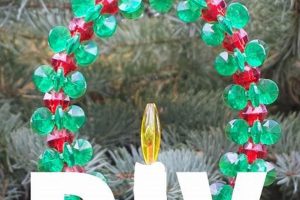The construction of decorative items for seasonal celebrations, specifically those intended for suspension and crafted from interlocking plastic bricks, represents a growing trend in personalized holiday dcor. These brick-built creations offer an alternative to traditional manufactured ornaments, allowing for customized designs and interactive building experiences.
The appeal of these handcrafted decorations lies in their inherent modularity and the potential for collaborative assembly. This approach fosters creativity, encourages problem-solving skills, and provides a tangible connection to the holiday season. Furthermore, the use of durable plastic ensures longevity, transforming ephemeral decorations into reusable keepsakes with sentimental value.
The subsequent sections will delve into specific design ideas, construction techniques, and considerations for material selection in the creation of these unique holiday decorations. The aim is to provide readers with practical knowledge to produce their own brick-built holiday adornments.
Construction Advice
The following recommendations are intended to enhance the structural integrity and aesthetic appeal of holiday decorations built from interlocking plastic bricks.
Tip 1: Prioritize Structural Stability: Internal bracing is essential, particularly for larger designs. Utilize Technic bricks and pins to create a rigid internal framework before adding decorative elements.
Tip 2: Optimize Weight Distribution: A balanced weight distribution prevents excessive strain on connection points. Evenly distribute heavier elements or strategically position support structures.
Tip 3: Employ Advanced Connection Techniques: SNOT (Studs Not On Top) techniques expand design possibilities and create smooth, unconventional surfaces. Master various SNOT orientations for intricate detailing.
Tip 4: Choose Appropriate Color Palettes: Limiting the color range to a cohesive scheme enhances visual harmony. Consider complementary or analogous color relationships for impactful aesthetics.
Tip 5: Secure Fragile Elements: Reinforce delicate protrusions or small, easily detachable pieces with glue or transparent tape. This measure safeguards against accidental breakage during handling and display.
Tip 6: Implement Secure Hanging Mechanisms: Integrate robust attachment points for ornament hooks or string. Utilize Technic bricks with axle holes for reliable suspension.
Tip 7: Experiment with Lighting: Incorporating LED lights adds a dynamic visual element. Strategically position lights to accentuate specific features or create ambient illumination.
These guidelines, when implemented thoughtfully, contribute to the creation of durable, visually appealing, and enduring holiday decorations. Careful planning and execution are paramount to achieving satisfactory results.
The subsequent concluding remarks will summarize the benefits of this approach and encourage further exploration of design possibilities.
1. Design Complexity
Design complexity, in the context of brick-built holiday decorations, refers to the level of intricacy and sophistication involved in a given ornament’s construction. This factor significantly influences both the aesthetic appeal and the structural requirements of the finished piece.
- Part Count and Variety
A higher part count often correlates with increased design complexity. The integration of diverse brick types, including specialized elements like tiles, slopes, and modified plates, allows for more nuanced shaping and detailing. However, it also necessitates more meticulous planning to ensure structural integrity and aesthetic coherence. Examples include spherical ornaments requiring complex tessellations or detailed character models using intricate layering techniques.
- Structural Integrity Requirements
As design complexity increases, so does the demand for robust internal support structures. Intricate designs may feature unsupported overhangs or delicate protrusions that are susceptible to breakage. Advanced building techniques, such as SNOT (Studs Not On Top) and layering, can create visually stunning results but require careful attention to load-bearing capacity and connection strength. Without adequate bracing, complex models may lack stability and durability.
- Building Technique Skill Level
More complex designs demand a higher level of building skill and familiarity with advanced techniques. Techniques such as complex SNOT orientations, offset connections, and intricate tiling patterns require experience and a thorough understanding of brick geometry. Novice builders may find simpler, more geometric designs more accessible, while experienced builders can push the boundaries of what is achievable with more complex models.
- Time Investment
Complex brick-built holiday adornments inherently require a greater time investment. Intricate designs necessitate meticulous planning, precise brick placement, and potentially multiple iterations to refine the design and ensure structural soundness. Builders must factor in the time required for design, sourcing materials, and the actual construction process. Simpler designs offer quicker gratification, while complex designs provide a more prolonged and challenging building experience.
The interplay between these facets underscores the critical role of design complexity in determining the success and satisfaction derived from creating brick-built holiday decorations. A thoughtful balance between aesthetic ambition, structural feasibility, and available resources is essential for producing durable, visually appealing, and personally meaningful seasonal ornaments.
2. Structural Integrity
Structural integrity constitutes a paramount consideration in the construction of brick-built holiday decorations. The inherent interlocking mechanism of plastic bricks provides a foundational level of stability; however, the demands of suspension and potential handling necessitate a robust design. Insufficient structural planning results in deformation, component separation, and ultimately, functional failure of the decorative item.
The fragility of many designs stems from cantilevered elements, unsupported spans, or inadequate internal bracing. For example, a miniature brick-built sleigh with extended runners lacking internal reinforcement will likely buckle under its own weight or when subjected to minor external forces. Similarly, ornaments replicating complex geometric forms, such as snowflakes, require strategic placement of connecting bricks to distribute stress and prevent breakage at vulnerable points. Advanced building techniques, such as incorporating Technic bricks and pins, offer solutions for reinforcing these weak points, creating a skeletal framework within the decorative shell. The absence of such reinforcement significantly diminishes the lifespan and usability of the finished product.
Effective integration of structural elements is critical for creating enduring and visually appealing brick-built holiday ornaments. Designs should prioritize weight distribution, employ robust connection methods, and address potential stress points proactively. Failing to adequately consider these factors undermines the creative effort and reduces the functional value of the ornament. The successful application of sound structural principles transforms a fragile creation into a lasting holiday treasure.
3. Color Palette
The strategic selection of colors constitutes a critical design element in brick-built holiday decorations. The chosen color scheme directly impacts the visual appeal, thematic relevance, and overall aesthetic success of the finished ornament. Thoughtful consideration of color relationships and their cultural connotations enhances the impact of these creations.
- Thematic Consistency
Color palettes should align with the intended theme of the ornament. Traditional holiday colors such as red, green, gold, and silver evoke familiar associations with Christmas, while blue and white often represent winter themes. Deviating from these established color schemes allows for creative expression but necessitates careful consideration to maintain visual harmony and avoid unintended thematic interpretations. For example, a pastel color palette may be suitable for a spring-themed ornament but could appear incongruous within a traditional Christmas setting.
- Contrast and Visual Hierarchy
Effective use of contrast enhances visual interest and creates a clear hierarchy of elements within the design. Juxtaposing light and dark colors, or employing complementary colors, draws attention to specific features and adds depth to the ornament. Conversely, a monochromatic color scheme can convey elegance and simplicity but requires careful attention to texture and form to avoid monotony. For example, using bright yellow accents against a dark blue background emphasizes specific details, while a grayscale ornament relies on subtle variations in brick texture to create visual interest.
- Brick Availability and Limitations
The available range of brick colors directly influences the design possibilities. Limited access to specific colors may necessitate compromises or creative substitutions. Designers must consider the practical constraints of brick availability and adapt their color palette accordingly. While digital design tools allow for experimentation with a wider range of colors, the physical limitations of brick production must be acknowledged. For instance, rare or discontinued brick colors may require sourcing from secondary markets, impacting project feasibility and cost.
- Material Properties and Color Accuracy
Variations in plastic formulation can affect the appearance of colors. Different brick types or production batches may exhibit slight color discrepancies, particularly in translucent or metallic finishes. Designers should be aware of these potential variations and select bricks from consistent sources whenever possible. These subtle differences, though often overlooked, contribute to the overall cohesiveness of the ornament’s visual presentation.
The selection and implementation of a well-considered color palette elevate brick-built holiday decorations from mere construction projects to visually compelling works of art. By carefully balancing thematic consistency, visual contrast, brick availability, and material properties, designers can create ornaments that embody the spirit of the season and reflect their individual artistic vision.
4. Attachment Method
The selection and implementation of an appropriate attachment method are critical to the functionality and longevity of brick-built holiday decorations. These plastic brick constructions, unlike traditional ornaments, require carefully engineered attachment points to ensure secure suspension without compromising structural integrity.
- Integrated Brick-Based Loops
One common approach involves constructing loops directly from interconnected bricks. This method utilizes Technic bricks with through-holes or strategically arranged standard bricks to form a closed loop. The loop then serves as an anchor point for ornament hooks or string. The strength of these integrated loops depends on the number of bricks used and the interlocking pattern. Inadequate integration can result in loop failure under the ornament’s weight, leading to detachment. Proper technique ensures load distribution across multiple connection points.
- Technic Pin Connections
Technic pins provide a robust and versatile alternative for creating attachment points. These pins insert into Technic brick holes, offering a secure and load-bearing connection. Incorporating Technic pin connections into the upper portion of the ornament and attaching a string or wire to the exposed pin head provides a reliable suspension mechanism. This approach is particularly suitable for heavier or more complex ornaments where standard brick connections may prove insufficient.
- Adhesive Solutions (Use with Caution)
While generally discouraged due to the semi-permanent nature of brick connections, certain adhesive solutions can provide additional security for attachment points. Cyanoacrylate (super glue) or epoxy resins, when applied sparingly, can reinforce brick-based loops or Technic pin connections. However, irreversible bonding necessitates careful consideration and precise application. This method should be reserved for situations where non-adhesive approaches are inadequate and where the user accepts the potential for permanent alteration.
- External Hanging Hardware Integration
Integrating commercially available ornament hooks or wire loops directly into the brick structure presents another option. These external components can be secured using various techniques, such as clamping them between bricks or utilizing adhesive to bond them to a flat surface. The selection of appropriate hardware depends on the size and weight of the ornament and the desired aesthetic. Care should be taken to ensure that the chosen hardware does not damage or stress the surrounding brickwork.
The choice of attachment method significantly influences the overall success of brick-built holiday ornaments. Proper planning and execution are paramount to ensuring secure suspension and preventing detachment, thereby preserving the aesthetic integrity and longevity of these handcrafted decorations. Selection should reflect weight, complexity, and the users experience level.
5. Brick Availability
The scope of plastic brick resources significantly impacts the feasibility and design possibilities within the domain of brick-built holiday ornaments. Resource limitations directly influence creative expression and necessitate adaptive problem-solving.
- Pre-Existing Collection Limitations
Individual brick collections typically possess inherent limitations in terms of color, type, and quantity. Ornament designs often require adaptation to accommodate these constraints. For example, a desired color scheme might necessitate substitutions based on available brick palettes, or a complex structural element might be simplified due to limited quantities of specific brick types. This dependence on pre-existing resources directly shapes the final aesthetic and structural design.
- Sourcing and Acquisition Challenges
Expanding brick resources involves navigating acquisition channels, including retail purchases, online marketplaces, and bulk brick suppliers. Access to specific brick types or colors may be restricted by regional availability, retailer inventories, or discontinued production lines. This sourcing process introduces logistical challenges and potentially increases project costs. Designs reliant on rare or difficult-to-obtain bricks face feasibility constraints, requiring either design modification or dedicated sourcing efforts.
- Budgetary Considerations
Brick acquisition requires financial investment. Budgetary limitations dictate the scale and complexity of potential ornament designs. Large-scale projects requiring substantial brick quantities necessitate significant expenditure, potentially exceeding budgetary constraints. Conversely, resourcefulness in utilizing existing brick collections and seeking cost-effective sourcing options enables greater design freedom within limited financial parameters. Financial factors directly influence the scope and ambition of ornament construction.
- Design Adaptation and Resourcefulness
Limitations in brick availability foster creative problem-solving and design adaptation. Constraints often stimulate innovative solutions, such as repurposing existing bricks for unconventional applications or modifying designs to accommodate available resources. This resourcefulness enhances building skills and fosters a deeper understanding of brick construction principles. The ability to adapt designs to overcome resource limitations distinguishes experienced builders and contributes to unique, personalized ornaments.
These interlinked factors emphasize that the creation of brick-built ornaments is not solely a function of design intent, but also a negotiation with the realities of brick resource accessibility. Overcoming these limitations through adaptation and resourcefulness is a critical aspect of successful brick-built holiday decoration construction. This process cultivates ingenuity and informs the final, tangible manifestation of creative vision.
Frequently Asked Questions
This section addresses common inquiries and concerns regarding the design, construction, and maintenance of holiday ornaments built from interlocking plastic bricks. The aim is to provide clear, concise answers to frequently encountered questions.
Question 1: What is the optimal method for ensuring structural integrity in complex designs?
For intricate brick-built ornaments, internal bracing is essential. Technic bricks and pins should be strategically integrated to create a rigid internal framework. This framework provides support for delicate features and prevents deformation or breakage under stress.
Question 2: How can appropriate attachment points for hanging be incorporated into the design?
Secure attachment points are critical for safe and reliable suspension. Utilize Technic bricks with axle holes or construct robust brick-based loops at the ornament’s apex. These attachment points should be integrated directly into the structural framework to distribute weight evenly.
Question 3: What types of adhesives, if any, are recommended for permanently securing brick connections?
The use of adhesives is generally discouraged due to the semi-permanent nature of brick connections. However, if absolutely necessary, small amounts of cyanoacrylate (super glue) or epoxy resin may be used sparingly to reinforce weak points. Exercise extreme caution to prevent irreversible bonding and potential damage.
Question 4: How should weight distribution be managed to prevent stress on connection points?
Achieving balanced weight distribution is crucial for preventing strain. Distribute heavier elements evenly throughout the structure or strategically position support structures to offset imbalances. Avoid concentrating weight on single connection points.
Question 5: What are the best practices for cleaning and maintaining brick-built holiday decorations?
Dust accumulation is a common issue. Gently clean ornaments with a soft brush or compressed air to remove dust and debris. Avoid using abrasive cleaners or immersing the ornaments in water, as this can damage the plastic or compromise structural integrity.
Question 6: How can lighting be effectively integrated to enhance the visual appeal of these decorations?
LED lights can add a dynamic visual element. Incorporate small, battery-powered LED lights strategically within the ornament’s structure to accentuate specific features or create ambient illumination. Ensure that the lights are securely mounted and do not interfere with the ornament’s structural integrity.
Key takeaways include prioritizing structural integrity, implementing secure attachment methods, and employing careful cleaning practices. These factors contribute to the longevity and visual appeal of brick-built holiday ornaments.
The subsequent section will provide a concluding summary and explore opportunities for further exploration in this area.
Conclusion
The preceding exploration of “lego ornaments diy” has delineated essential factors contributing to the creation of aesthetically pleasing and structurally sound holiday decorations. Considerations encompassing design complexity, structural integrity, color palette selection, attachment methodologies, and material availability directly influence the overall success of these brick-built projects. A thorough understanding of these principles enables the construction of durable and visually compelling ornaments.
Continued innovation within this domain necessitates further investigation into advanced building techniques and material science. Exploration of novel connection methods and the integration of electronic components represents potential avenues for future development. These endeavors will contribute to the evolution of brick-built ornaments as a sophisticated and enduring form of holiday expression.







